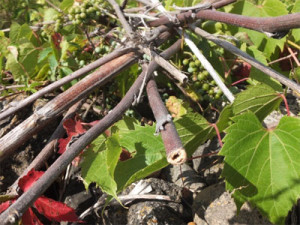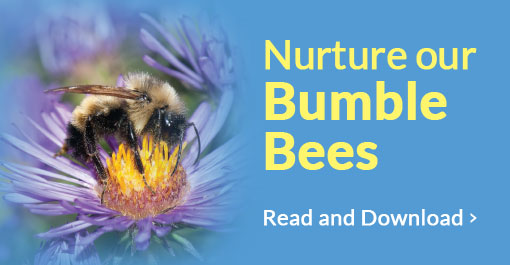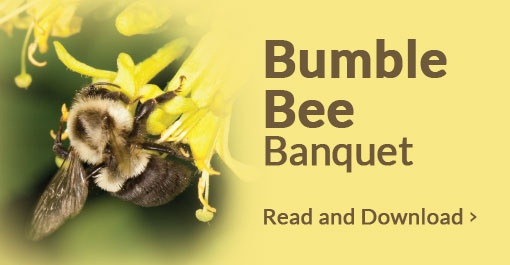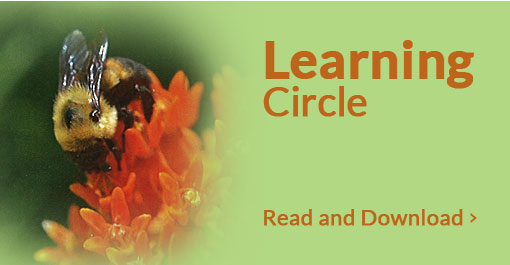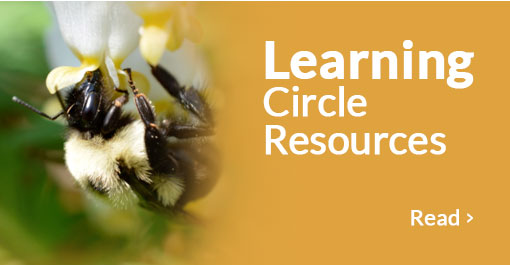Nurturing Prairie Pollinators
Can we “make a difference” in the challenge of fewer plant pollinators?
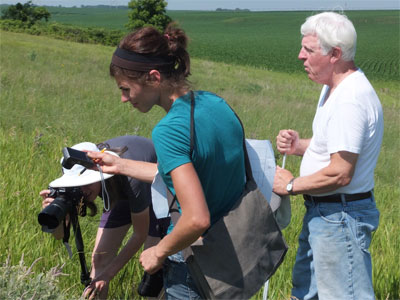
Heather Holm (left), Sarah Jordan (center), and Jim Nelson (right), inspecting native pollinators on lead plant
Like many prairie landowners we believe that pollinators are a key to the health and vigor of our prairie landscape. While many plants (especially grasses) can “get by” through self- or wind-pollination, the majority of prairie forbs rely on pollinating insects to transfer pollen from one plant to another, to ensure abundance of flower seed and ensuring plant regeneration. As much as one third of fruit and vegetable crops depend on pollinators, and traditional pollinators such as European honey bees have had serious declines in recent years. For these reasons, it has become
more important to nurture and promote native bees for prairie health and vitality of fruit and vegetable crops. The term “nurture” connotes a broader perspective to the landscape surrounding our Dakota County remnant/restored prairie, engaging a greater community of people, taking a longer term multi-season perspective and a willingness for systematic experimentation with intentional actions to promote pollination.
To nurture our native pollinators (especially bees) I invited Sarah Foltz Jordan of the Xerces Society to prepare a Pollinator Conservation Activity Plan. While doing the field work for that plan I also invited Heather Holm, author of Restoring the Landscape with Native Plants online blog to “brainstorm” improvements to my prairie. I commend the publications of the Xerces Society and the Restoring the Landscape blog for authoritative and useful information. While the final plan will contain specific recommendations based on my soil type, existing vegetation, and adjacent agricultural context; the following are some general discussion items:
More Native Plants, More Blooms, More Density and More Continuity
Native plants, not cultivars are most likely to have sufficient store of pollen (protein) and nectar (carbohydrates) to sustain native bees. According to historic studies of vegetative composition, our prairie has far too many (wind pollinated) grasses, so we utilized lists of native bee favorites from the DNR, the Xerces Society and other sources.
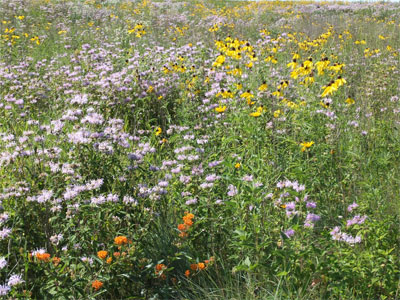
After a plant inventory, we discovered that we had many good foundation forbs such as Bee Balm (Monarda fistulosa) and Milkweed (Asclepia tuberosa and A. syriaca), but were generally lacking in other bee favorites such as Mountain Mint (Pycnanthemum virginianum), and native thistles (e.g., Circium discolor). In addition, our prairie is somewhat deficient on early season blooming plants. We will augment our small population of Golden Alexander’s (Zizia aptera) and select another variety of Penstemon to assure that we have more quantity and variety of flowering plants when bees are first emerging from hibernation. Also, we will definitely begin adding some spring-blooming flowering shrubs like Dogwood (Cornusspp.). We seem to have an abundance of plants blooming mid-summer. Since our late season is also a little sparse, we will add Gentians (Gentianaspp.), Aster ssp., and possibly increase our numbers of Stiff Goldenrod (Solidago rigida). These actions will help ensure that we In the future we will strive to actually have many flowers with overlapping blooms times,providing bees with a continuity of food resources throughout the season. We will continue to plant forbs in large patches and massed swirls to allow bees more efficient access the blooming plants.
Proactive Steps to Enhance Nesting Success
Perhaps the most difficult challenge in nurturing pollinators involves nesting sites. Different species have different nesting requirements. Nests of ground nesting bees occur mostly in bare or sparsely vegetated patches of soil in well drained areas. Wood and cavity nesting bees will often nest in beetle tunnels or hollow stems of some plants. Bumble bee nests can be found in a variety of habitats, including abandoned holes of rodents, under rock piles, and in the hollow spaces under bunchgrasses. With a spirit of curiosity, we are trying many different approaches to increase pollinator nesting habitat. We attempted to attract Bumble Bees with a self-constructed 2 chamber buried box with a ¾ inch pipe opening to the surface. Placement, orientation and timing, distance from forage is all variables that we are studying. Also for bumble bees, we will monitor our rock piles for activity and leave plenty of native bunchgrass patches undisturbed for bumble bee nesting habitat. For cavity-nesting bees, rather than rely on artificial nesting boxes, we were persuaded that the most fundamental nesting strategy was to preserve natural habitat. We girdled some invasive trees to create snags and created piles of field stone, mixed brush, and pithy plant stems to provide a variety of cavities that are dry, dark and attractive to bees. Several of our native plant species have stems with hollow or pithy centers that are well-suited for this purpose, including rattlesnake master (Eryngium yuccifolium), lead plant (Amorpha canescens), and compass plant (Silphium laciniatum). For ground nesting bees, we may experiment with creating designated areas of undisturbed bare ground in parts of the property that have good drainage (either naturally, or because sand has been hauled in). Overall, the keys to promoting native bee nesting success seem to be: (1) protect natural nesting sites from disturbance and (2) where necessary provide structures that match bee preferences.
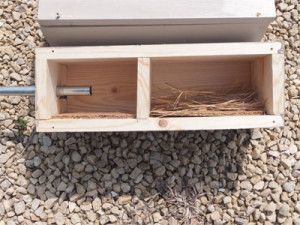
Bumble Bee Nesting Box
Mowing and Burning Maintenance: Zones and Intervals
Once we established pollinators as a priority, certain land management approaches seemed more sensible. We believe that prescribed burning has often been useful to remove thatch and jump start the growing season. However, burning tends to favor warm season grasses. While the grasses are beautiful and often support forbs, they can shade out and in sometimes out compete some of the more useful forbs. Burning on a whole plot basis can destroy an entire generation of insects and other life. Mowing combined with modest litter removal (using a flexible harrow)
can allow for greater access to sun light. Mowing maintenance has many advantages. It can be accomplished by a 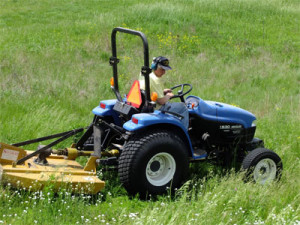 single person on a flexible schedule with less need for advance preparation compared to burning. Currently the removed litter is being composted for gardening uses. On our farm we have decided to expand the interval between burns to about 4-5 years (rather than 2-3) and rely more on mowing. Our mowing is “rough” and leaves a mosaic of small patches of un-mowed areas. We will divide our 28 acres into about 3 non-contiguous zones. This is significantly more work. However, we hope the more intensive management will produce blooming plants attractive to pollinators. A robust insect community is also attractive to many graceful songbirds and other wildlife.
single person on a flexible schedule with less need for advance preparation compared to burning. Currently the removed litter is being composted for gardening uses. On our farm we have decided to expand the interval between burns to about 4-5 years (rather than 2-3) and rely more on mowing. Our mowing is “rough” and leaves a mosaic of small patches of un-mowed areas. We will divide our 28 acres into about 3 non-contiguous zones. This is significantly more work. However, we hope the more intensive management will produce blooming plants attractive to pollinators. A robust insect community is also attractive to many graceful songbirds and other wildlife.
Protecting Pollinator Health: Bee Careful
There are many precautionary proverbs with the thought that it is better to take care that a problem does not happen than have to solve the problem afterwards. Many modern farm chemicals are effective for eliminating noxious weeds and pests, but extremely detrimental to nativepollinators. While there may be situations where chemicals are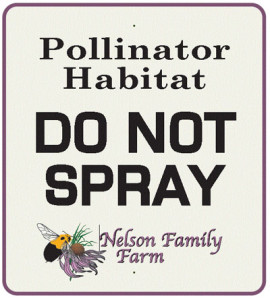 required, we continuously try to educate ourselves to identify alternatives and minimize chemical impacts by applying them properly under optimum conditions. Our farm is a commercial farm and we are surrounded by neighboring farms that rely on chemicals throughout the growing season. While we have significant grass buffers greater than 40 feet, we will evaluate in the coming year the possibility of creating some hedgerows to preclude pesticide drift to some of our most vulnerable areas. In particular, we are concerned about the drift of neonicitinoid insecticides, since these chemicals are known to be very toxic to bees, and their use in corn production is common-place. To minimize the possible detrimental effects of farm chemicals, we have formally requested our neighbors to use cautions with chemicals near our fields. We have also posted some “Do Not Spray” awareness signs at our field boundaries. An important step is an annual neighborhood “Open Houses” to showcase our prairie activities and build support for protecting our prairie and its varied life forms. When people understand our objectives they can harmonize their agricultural activities to complement our pollinator goals.
required, we continuously try to educate ourselves to identify alternatives and minimize chemical impacts by applying them properly under optimum conditions. Our farm is a commercial farm and we are surrounded by neighboring farms that rely on chemicals throughout the growing season. While we have significant grass buffers greater than 40 feet, we will evaluate in the coming year the possibility of creating some hedgerows to preclude pesticide drift to some of our most vulnerable areas. In particular, we are concerned about the drift of neonicitinoid insecticides, since these chemicals are known to be very toxic to bees, and their use in corn production is common-place. To minimize the possible detrimental effects of farm chemicals, we have formally requested our neighbors to use cautions with chemicals near our fields. We have also posted some “Do Not Spray” awareness signs at our field boundaries. An important step is an annual neighborhood “Open Houses” to showcase our prairie activities and build support for protecting our prairie and its varied life forms. When people understand our objectives they can harmonize their agricultural activities to complement our pollinator goals.
While the declining number of pollinators is challenge to Nature and our food supplies, meaningful progress can be achieved. Working together, private landowners can address this issue through following pollinator friendly guidelines; sharing knowledge gained and intentionally nurturing their native pollinators with thoughtful actions.
Works Cited
Mader, Eric. Attracting Native Pollinators: Protecting North America’s Bees and Butterflies: The Xerces Society Guide. North Adams, MA: Storey Pub., 2011. Print.
Tix, Daniel, Jo Anna Hebberger, Elizabeth Vaughan, and Iris Charval. “The Effects of Fire versus Mowing on.” (2003): n. pag. Web.
Holm, Heather.” Restoring the Landscape with Native Plants. N.p., n.d. Web. 23 July 2013.
Hatfield, R., S. Jepsen, E. Mader, S.H. Black, and M. Shepherd. 2012. Conserving Bumble Bees. Guidelines for creating and managing habitat for America’s declining pollinators. 32 pp. Portland. OR: The Xerces Society for Invertebrate Conservation.
Hopwood, Jennifer, Mae Vaughn, Matthew Shepard, David Biddinger, Eric Mader, Celeste Mazzaxano, 2012, Are Neonicitinoids Killing Bee? 28pp. Portland OR: The Xerces Society for Invetebrate Conservation.




